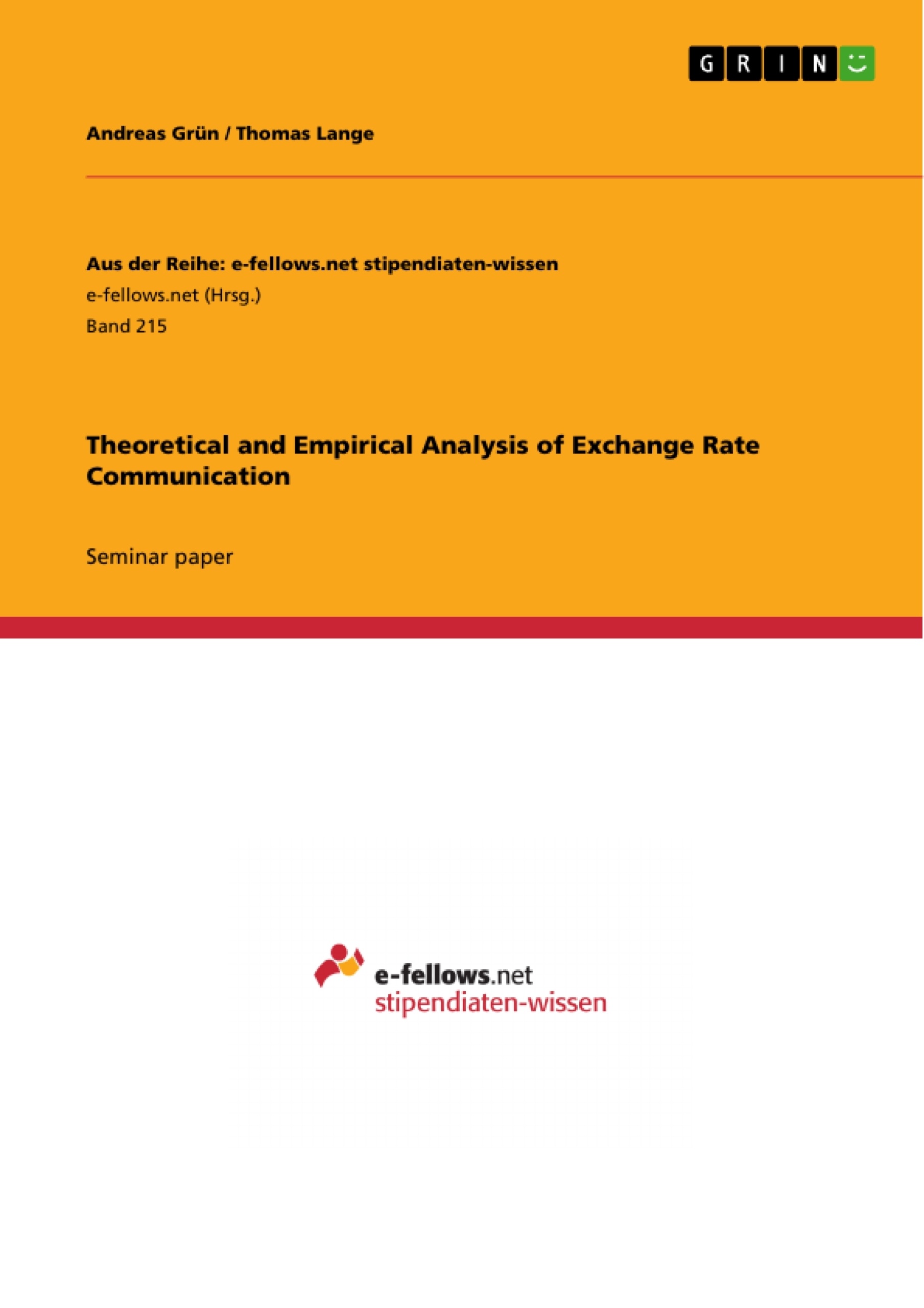The overall aim of this paper is first to review existing papers and based on this to conduct own research in the field of the effect of macroeconomic news in general and, more specific,
ECB communication on exchange rates.
Exchange rate communication is a special form of macroeconomic news that is issued by central banks. Existing research on the effect of this communication has lead to often diverging result that illustrate the high intensity and dynamics of the current academic debate with regard to this matter. On one hand evidence of a relatively high impact on the mean and volatility of currency markets is found (e.g. by Fratzscher (2004)) whereas others (e.g. Jansen, de Haan (2005)) do not chronicle statistically significant and persistent results. The difficulty of understanding the response of currency markets becomes even harder when the significance of the respective context of news e.g. day of the week effect is considered or asymmetric responses are taken into account.
Among the group of central banks especially the European Central Bank has attracted high attention in academic research. Preceding studies generally create dummy variables to measure ECB communication. These variables are then by different methods regressed against the exchange rate or other financial assets in order to find explanatory relationships. This paper follows this approach by using the dummy variable of Rosa, Verga (2006).
Ultimately we arrive at three major findings using our dataset. (a) Communication and interest changes by central banks are interpreted differently by currency markets: While
communication that suggests raising interest rates seems to be an alarming warning signal with regard to possible inflation, interest rate increases see to be interpreted as attempts to mitigate this danger. (b) There are indicators that the exchange rate reacts more slowly to news coming from the U.S. (c) Based not on high frequency but on daily data we merely arrive at results that do not allow us to reject the null hypothesis that exchange rate communication actually does not have a significant impact on exchange rate returns.
Inhaltsverzeichnis (Table of Contents)
- Introduction
- How do markets react to macro news?
- What is news and how does it affect the mean and volatility of exchange rates?
- Velocity of news absorption
- Context of news: What impact does it have?
- Asymmetric reaction to news
- Central Banks
- Why are Central Banks and especially the ECB of special academic interest?
- How can we classify the existing research in the ECB-field?
- What can central banks achieve by communication?
- Empirical Evidence for exchange rate communication efficiency
- Which existing papers have similar empirical focus?
- How do existing papers measure communication?
- What econometric methodology has been used?
- What effects could the existing research discover?
- What do those results mean for the actions of the ECB?
- Own empirical findings
- Data sources
- Which is the most appropriate regression?
- Why could lag specification be helpful?
- What is the economic reasoning behind the sign and the size of the coefficients?
- Which results does further testing yield?
- Interpretation of Results / Implications for ECB
- Conclusion
Zielsetzung und Themenschwerpunkte (Objectives and Key Themes)
The paper aims to analyze the impact of ECB communication on exchange rates, particularly the Euro/Dollar exchange rate. It begins with an overview of relevant theoretical aspects and prior research, culminating in an original study to assess the effectiveness of communication on exchange rates. The study follows a structured approach, examining how currency markets react to macroeconomic news in general, then shifting to a specific focus on central banks, especially the ECB, and their communication strategies. The paper further investigates the empirical evidence for exchange rate communication efficiency and then presents the author's own empirical findings and their implications for the ECB.
- Market reaction to macroeconomic news
- Central bank communication and its impact on exchange rates
- Empirical analysis of the relationship between ECB communication and Euro/Dollar exchange rate
- Econometric methodology and its limitations
- Implications of the findings for ECB policy
Zusammenfassung der Kapitel (Chapter Summaries)
Chapter 2 delves into how currency markets respond to macroeconomic news, exploring how news is defined, classified, and absorbed into market prices. It examines the impact of news on exchange rate mean and volatility, and considers the role of contextual factors and asymmetric market responses. Chapter 3 shifts focus to central banks, particularly the ECB, discussing the growing academic interest in their actions and the classification of existing research on the ECB. It explores the potential of central bank communication to influence economic outcomes. Chapter 4 examines studies specifically analyzing the effects of ECB communication, setting the stage for the author's own study in Chapter 5. Chapter 5 presents the author's empirical findings, detailing the data sources, regression models, and economic reasoning behind the results. It also discusses limitations of the data and methodology.
Schlüsselwörter (Keywords)
This paper focuses on the impact of central bank communication, particularly from the ECB, on exchange rates, especially the Euro/Dollar exchange rate. Key themes include market reaction to macroeconomic news, exchange rate volatility, central bank communication strategies, econometric modeling, and empirical analysis of the relationship between communication and exchange rate movements. The study utilizes data sources and econometric techniques to analyze the influence of communication on the exchange rate and draw implications for ECB policy.
- Citation du texte
- Andreas Grün (Auteur), Thomas Lange (Auteur), 2007, Theoretical and Empirical Analysis of Exchange Rate Communication, Munich, GRIN Verlag, https://www.grin.com/document/178413



